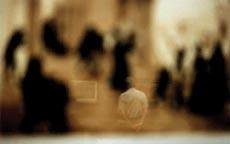Seen | Unseen
dal 8/1/2009 al 13/2/2009
Segnalato da
Madeline Djerejian
Kate Drendel
Charles Harlan
Brad Robinson
Surveillance Camera Players
Futaba Suzuki
Edin Velez
Hsuan Hsuan Wu
Peg Curtin
8/1/2009
Seen | Unseen
NurtureArt, New York
Group show

Curated by Peg Curtin
"Twenties and thirties, it was the role of government. Fifties and sixties, it was
civil rights. The next two decades, it's gonna be privacy. I'm talking about the
Internet. I'm talking about cellphones. I'm talking about health records . . .
in a country born on a will to be free, what could be more fundamental than this?"
Spoken in 2001 by fictional character Sam Seaborne in the popular television drama
The West Wing, this statement rings uncannily true today. Advancing surveillance
and communication technologies coupled with a government preoccupied by a perceived
increase in terrorist threats are pushing the bounds of our ideas of privacy and
protection.
Is the idea of surveillance in the mind of a populace a more powerful tool than
the surveillance itself? What does surveillance, or a perception of surveillance,
do to us as subjects? How do we now see others, and imagine ourselves to be seen?
Even more importantly, how do we come to perform frequent acts of self-surveillance?
Blurring lines between observer and observed, the eight provocative emerging artists
in Seen | Unseen cross typically taboo lines by openly photographing strangers,
directly challenging and mocking surveillance cameras, and willingly placing themselves
in the role of the observed, and us in the role of observers. Images are reflected,
complicated, and obscured. Installations reconstruct and appropriate in miniature
the surveillance of our homes and property, exposing our phobias, and anxiously
recontextualizing accepted security methods. Video works invert the supposed anonymity
of large crowds and explore our culture's obsession with reality television.
Seen | Unseen asks us to question our boundaries and consider the future of a culture
increasingly consumed with the need to see and be seen.
Through public performances in front of existing surveillance cameras, the Surveillance
Camera Players talk back to the anonymous eye of the lens through the use of signs
and gestures.
Edin Velez positions himself and his video camera in front of escalators and elevators.
He points his lens into the tides of people and captures authentic moments of
expression
and gesture.
Madeline Djerejianconceals her intention of photographing museum
visitors by focusing on their reflection in the glass that covers
masterworks.
Kate Drendel turns the camera on herself and assumes the role of someone who has
left herself vulnerable to our gaze. The black and white image of a melancholy
woman gazing out the window is reflected onto an old television screen.
Hsuan Hsuan Wu's video is staged in the middle of Times Square. Wu remains focused
on her journal writing as her cameraman records the pedestrians who gawk and ignore
her.
Brad Robinson's Public Interest, dealing with those who aspire to be on reality
television shows and the American culture that has become obsessed with them, examines
our need to observe and the desire to be observed.
In the mode of self-conscious examination and re-examination, Futaba Suzuki constructs
idealized homes and then places them under surveillance. The images that are pulled
from her surveillance cameras are then projected onto the constructed home.
Charles Harlan uses the surveillance camera in a way that neutralizes its power.
Misusing useful tools inverts the concept of usefulness and leads to new ways
of understanding something outside of its prescribed function.
Seen Unseen is a NURTUREart Emerging Curators' Program Collaboration.
Directions to NURTUREart Gallery and Emerging Curators' Resource Center:
L train to the Grand Street stop. From the exit walk one block east of Bushwick
Avenue (past the school) on Grand Street. Look for the NURTUREart Banner at 910
Grand Street, just after the traffic light at Waterbury Street. The gallery is
open Thursday through Monday from 12-6.
NURTUREart Non-Profit is a 501(c)3 registered charitable organization founded in
1997 by George J. Robinson. NURTUREart is committed to nurturing emerging artists
and curators through exposure, enrichment and opportunity. It is funded in part
by the Leibovitz Foundation, the New York State Council on the Arts, the New York
City Department of Cultural Affairs, the Andy Warhol Foundation, the Greenwall
Foundation,
and the Milton and Sally Avery Foundation. We appreciate their support.
NurtureArt
475 Keap St., Ground Floor (Williamsburg, Brooklyn) - New York



